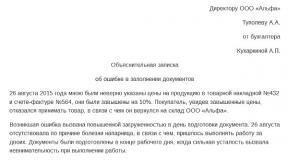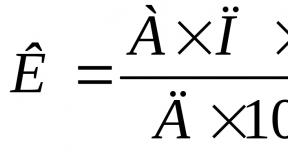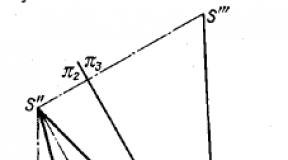Hello student. The main provisions of accounting and analysis of the financial results of an enterprise Accounting for financial results in a nutshell
One of the main objectives of the organization is to make a profit. However, not always the financial result of the enterprise is positive. Accounting for financial results and the use of profits allows the organization to control current activities and plan further work.
What is financial result
Each organization for internal control summarizes its activities. Such results are called financial results. It can be positive or negative. A positive result is also called the profit of the enterprise. It occurs when income exceeds expenses. In other words, the organization works "in plus". Profit as a whole signals the effectiveness of the activity, however, if you analyze its dynamics (statistics for several years), you can identify an increase or decrease in its size, which indicates the effectiveness of work.
A loss appears in a situation where income does not cover expenses and the company operates "in the red." The occurrence of this indicator is a wake-up call for management, indicating inefficiency and requiring action to improve performance.
Accounting for financial results and the use of profits is necessary to control the activities of the company, tactical and strategic planning, as well as for external users who can use it to make a decision on investing funds by investors or on issuing a loan by a banking organization. Accounting provides data for analyzing the results of work.
Accounting for financial results
There are several accounts for recording the results of activities, and their use depends on the activity from which income is received and expenses are incurred. Income and expenses are divided into two groups:
- from normal activities;
- from other activities.
The activities prescribed in the constituent documents and characteristic of the organization are normal. To account for financial results from ordinary activities, account 90 and sub-accounts to it are applied. Profit or loss from ordinary activities is recorded as:
Other activities include those that are not characteristic of the work of the firm. They can be called incidental income or expenses because the organization did not originally plan to bear these expenses or receive such income.
Other income includes:
- benefit from investments in securities;
- positive differences arising from the growth of the exchange rate;
- surplus identified during the inventory of property;
- accounts payable written off due to the expiration of the limitation period, etc.
Other expenses are:
- fines, penalties, forfeits paid to counterparties or to the state budget;
- negative differences that appear due to the depreciation of the currency;
- accounts receivable after the statute of limitations, etc.
To account for other income and expenses, account 91 and sub-accounts to it are provided. Profit or loss from other activities is recorded in the entries:
Accounting for financial results and use of profits
The final financial result is determined at the end of the year and is reflected in accounts 99 and 84:
Profit is an excellent result of the company's activities. But its receipt is not enough for further growth. In this regard, it is necessary to take into account the rational use of profits. Net profit is reflected in account 84 and arises after the payment of income tax. Subsequently, the net profit is distributed. Directions of net profit are determined by the management, they include:
- repayment of losses incurred in past periods;
- formation of reserve capital;
- payment of dividends to members of the company.
The financial result of the economic activity of the enterprise is determined by the indicator of profit or loss, formed during the calendar (economic) year.
The financial result is the difference between the amounts of income and expenses of the enterprise. The excess of income over expenses means an increase in the property of the enterprise - profit, and the excess of expenses over income - loss. The financial result received by the enterprise for the reporting year in the form of profit or loss, respectively, leads to an increase or decrease in the equity capital of the enterprise.
The accounting regulations "Income of the organization" (PBU 9/99) and "Expenses of the organization" (PBU 10/99), approved by Orders of the Ministry of Finance of Russia dated 06.05.1999 No. 32n and No. 33n, respectively (as amended and supplemented), recognize an increase in income , and expenses - a decrease in economic benefits as a result of the receipt or disposal of assets, as well as the repayment or incurrence of liabilities, leading to corresponding changes in the capital of the enterprise. In the said normative acts, income and expenses are grouped for their reflection in accounting and reporting, their definition and the procedure for recognition in accounting are given.
According to PBU 10/99 (clause 16), expenses are recognized in accounting under the following conditions:
The expense is made in accordance with a specific contract, the requirement of legislative and regulatory acts, business customs;
The amount of the expense can be determined;
There is confidence that as a result of a particular transaction there will be a decrease in the economic benefits of the organization. There is certainty that a particular transaction will reduce the entity's economic benefits when the entity has transferred the asset, or there is no uncertainty about the transfer of the asset.
If at least one of the named conditions is not fulfilled in relation to any expenses incurred by the organization, then the organization's accounting records recognize receivables.
Depreciation is recognized as an expense based on the depreciation expense based on the value of the depreciable assets, their useful lives and the entity's depreciation methods.
Expenses are subject to recognition in accounting, regardless of the intention to receive revenue, operating or other income and from the form of the expenditure (cash, in kind and other).
Expenses are recognized in the reporting period in which they occurred, regardless of the time of actual payment of funds and other form of implementation (assuming the temporal certainty of the facts of economic activity).
Expenses are recognized in the income statement:
Taking into account the relationship between expenses incurred and receipts (correspondence of income and expenses);
By their reasonable distribution between the reporting periods, when the expenses cause the receipt of income during several reporting periods and when the relationship between income and expenses cannot be clearly determined or is determined indirectly;
For expenses recognized in the reporting period, when it becomes certain that they will not receive economic benefits (income) or receive assets;
Regardless of how they are taken for the purposes of calculating the taxable base;
When liabilities arise that are not contingent on the recognition of related assets.
According to PBU 9/99, expenses from ordinary activities are revenue from the sale of products and goods, income related to the performance of work, the provision of services (hereinafter referred to as revenue).
Revenue is recognized in accounting under the following conditions (clause 12 of PBU 9/99):
a) the entity has a right to receive the proceeds arising from a specific contract or otherwise appropriately evidenced;
b) the amount of proceeds can be determined;
c) there is confidence that as a result of a particular transaction there will be an increase in the economic benefits of the organization. There is certainty that as a result of a particular transaction there will be an increase in the economic benefits of the organization, there is a case when the organization received an asset in payment or there is no uncertainty regarding the receipt of the asset;
d) the right of ownership (possession, use and disposal) of the product (goods) has passed from the organization to the buyer or the work has been accepted by the customer (the service has been rendered);
e) the costs to be incurred or to be incurred in connection with this transaction can be determined.
If at least one of the named conditions is not fulfilled in relation to cash and other assets received by the organization in payment, then the organization's accounting records are recognized as accounts payable, and not revenue.
The organization may recognize in accounting revenue from the performance of work, the provision of services, the sale of products with a long production cycle as the work, service, product is ready or upon completion of the work, the provision of services, the manufacture of products as a whole.
The proceeds from the performance of a specific work, the provision of a specific service, the sale of a specific product are recognized in accounting as soon as they are ready, if it is possible to determine the readiness of the work, service, product.
In relation to different in nature and conditions for the performance of work, the provision of services, the manufacture of products, an organization can apply simultaneously in one reporting period different methods of recognizing revenue, provided for in paragraph 13 of PBU 9/99.
If the amount of proceeds from the sale of products, the performance of work, the provision of services cannot be determined, then it is accepted for accounting in the amount of the expenses recognized in accounting for the manufacture of these products, the performance of this work, the provision of this service, which will subsequently be reimbursed to the organization.
The financial result of the economic activity of the enterprise is formed from two of its components, the main of which is the result obtained from the sale of products, goods, works and services, as well as from business operations that are the subject of the enterprise’s activity, such as the rental of fixed assets for a fee, the transfer in the paid use of intellectual property and investment in the authorized capital of other enterprises.
The second part in the form of income and expenses not directly related to the formation of the main sales financial result (financial result from sales) forms the other financial result, which includes operating and non-operating income and expenses. If during the reporting period the company received a profit from the sale of products, goods, works, services and other operations that are the subject of its activity, then its entire financial result will be equal to the profit from sales plus other income minus other expenses. If an organization incurs a loss on sales, then its total financial result will be equal to the sum of the loss on sales plus other expenses minus other income.
The overall financial result obtained in this way is adjusted for the amount of losses, expenses and income due to extraordinary circumstances of the enterprise's economic activity.
The implementation financial result is determined at the end of each reporting period. If the financial result is profit, then it is reflected in the credit of account 99 "Profit and Loss" in correspondence with the debit of account 90 "Sales". If the result of the enterprise's activity is a loss, then it is reflected in the debit of account 99 "Profit and Loss" in correspondence with the credit of account 90 "Sales".
Other income and expenses included in the overall financial result of the organization are reflected in accounting separately from the financial result from sales on account 91 “Other income and expenses” by “expanded” reflection of individual items of income and expenses during the reporting period.
In the financial statements of profit and loss, income may be shown net of the corresponding expenses related to these incomes, in cases where it is provided for or not prohibited by accounting rules or if individual items of income and related similar items of expenses are not significant for characterizing financial position of the organization.
Other income is reflected in the credit of account 91 “Other income and expenses” in correspondence with the debit of accounts for cash, settlements, inventory and other relevant accounts.
Analytical accounting on account 91 “Other income and expenses” is kept for each type of other income and expenses. At the same time, the construction of analytical accounting for other income and expenses related to the same financial or business transaction should provide the ability to identify the financial result for each transaction.
It should be borne in mind that entries on accounts 90 and 91 are made accumulatively from the beginning of the reporting year so as to ensure the formation of the necessary information for compiling a profit and loss statement (form No. 2).
The balanced result of account 91 “Other income and expenses” in the form of profit and loss is written off monthly, like the balance of account 90 “Sales”, to the final accumulative account of financial results 99 “Profit and loss”: the balance in the form of profit - to the credit of account 99 s the debit of account 91, the balance in the form of losses - to the debit of account 99 from the credit of account 91.
Extraordinary income and expenses are reflected directly on account 91 “Other income and expenses”: income - on credit, expenses - on debit in correspondence with the corresponding accounts for cash, inventory, settlements, etc.
On account 99, at the end of the first quarter, the interim financial result for the first quarter is revealed, at the end of the second quarter - for the first half of the year, at the end of the third quarter - for 9 months of the year and at the end of the fourth quarter - the final financial result for the entire reporting period.
The information structure of account 99 “Profit and Loss” for the formation of the final financial result should ensure the receipt of:
1) systemic reliable information on accounting profit - an indicator necessary to determine the taxable base for income tax by appropriate tax adjustment of accounting profit;
2) information on the formation of the final indicator of net retained earnings, which is at the disposal of the founders (participants) of the enterprise for distribution at the end of the financial year and transferred in December of the reporting year to account 84 “Retained earnings (uncovered loss)”.
In the system of accounts reflecting the financial results of the enterprise for the reporting year, all the necessary information about the indicators contained in the financial statements on profit and loss (form No. 2) should be generated.
Analytical data on all accounts of this group are involved as turnovers and balances in the formation of indicators of the income statement for the reporting year.
At the end of the calendar year, from the amount of actual accounting profit received by the enterprise for the reporting year, the final calculation of the amount of income tax due to the budget at the established tax rate is made as a matter of priority. At the same time, the amount of taxable profit differs from the accounting profit of the enterprise by the amount of those positive and negative adjustments that are established by the Tax Code of the Russian Federation on income taxation.
A complete list of all adjustments of reported income to the taxable level is given in the form of a certificate attached to the tax return on the calculation of tax on actual income.
Due to the fact that the profit indicator in the current quarterly statements does not represent the final financial result, current income tax payments calculated quarterly, as well as intra-quarterly payments, are of an advance nature. This current (essentially, advance) distribution of profits is now reflected during the year in the debit of account 99 "Profits and losses" in correspondence with the credit of account 68 "Calculations on taxes and fees".
The amount remaining after the deduction of the tax accrued from it from the profit is called net profit, which does not comply with international accounting practice. In foreign literature, this term has a different meaning, it means the balanced result of comparing all the income and expenses of the enterprise, i.e. the entire financial result.
With the convergence of Russian accounting practice with international accounting and reporting standards, the concept of net profit as remaining at the disposal of the enterprise has practically ceased to exist. Its place was taken by a new concept - "retained earnings of the reporting year." This part of the profit is now disposed of by the enterprise after the completion of the process of its formation. From the net profit, the enterprise (both before and now) reimburses payments under the sanctions of the relevant authorities for non-compliance with the rules of taxation and payment of similar mandatory payments to social state non-budgetary funds (pension fund, social and medical insurance funds).
These expenses are reflected in the accounting records as they are accrued by the entry:
Debit account 99 "Profit and loss"
Credit of account 68 "Calculations on taxes and fees",
Credit of account 69 "Calculations for social insurance and security."
From the accounting profit, the enterprise reimburses, as a matter of priority, the costs of paying current payments on income tax, current payments on taxes to the local budget paid at the expense of net profit, as well as fines covered by net profit, penalties for non-compliance with taxation rules and violation of the procedure for settlements with state off-budget social funds, payments to which are equated to tax.
The amount of accounting profit received after deducting the listed operating expenses is retained, i.e. net profit that comes to the disposal of the founders of the enterprise for its use after the approval of the results of production and financial activities for the past reporting year. In accordance with paragraph 83 of the Regulation on Accounting and Accounting in the Russian Federation, the financial result of the reporting period is reflected in the balance sheet as retained earnings (uncovered loss), i.e. the final financial result revealed for the reporting period, minus taxes due from profits established in accordance with the legislation of the Russian Federation and other similar obligatory payments, including sanctions for non-compliance with taxation rules.
In the current financial statements, the financial result is defined as the balance of account 99 “Profit and Loss”. In the annual financial statements, this indicator is reflected after the reformation of the balance sheet in December according to the balance of account 84 “Retained earnings (uncovered loss)”, subaccount 1 “Retained earnings (loss) of the reporting year”, while the corresponding balance on account 99 is in the form profit or loss is transferred to account 84, sub-account 1 "Retained earnings (loss) of the reporting year". Retained earnings are credited to sub-account 84-1, and uncovered losses are debited to the same sub-account.
The most important results of the financial and economic activities of any enterprise, which characterize the effectiveness of its work, are considered to be the amount of income and expenses. They also form the financial result, which can be both positive and negative, depending on how efficiently the enterprise has worked. Audit, inventory and accounting of the financial result allows the organization to control the current work and plan further activities.
What is the financial result of the enterprise
Based on a comparison of debit and credit turnover for a particular reporting period, it is possible to determine the financial result of the company's activities - net gain or loss. In a simple sense, the financial result is the results of the enterprise for a particular period. In order to understand how effectively the organization is functioning, accounting for profit and loss is carried out. The financial result is determined for the organization as a whole, and the accounting includes a number of data:
- sale of manufactured products, works or services;
- operating activities;
- non-operating transactions.
This also takes into account accrued taxes, fees, as well as fines that were paid out of profits.
Legal Framework
Today in the Russian Federation there is a large list of standards, regulations that in one way or another affect the accounting activity itself, accounting and analysis of financial results. Firstly, this is the Tax Code of the Russian Federation, where special attention is paid to taxable profits and the federal law “On Accounting”. In addition, there are a number of other documents:
- PBU "Expenses of the organization" (No. 10/99);
- PBU "Income of the organization" (No. 9/99);
- Account correspondence;
- PBU "Accounting statements of the enterprise" (No. 4/99);
- Charts of accounts;
- PBU "Accounting policy of the organization" (No. 1/2008);
- International Financial Reporting Standards;
- PBU "Information on segments" (No. 12/2010), etc.
Profit in accounting - the concept and its types
Accounting profit is the difference between an organization's income and expenses. It can be positive or zero. In the first case, there is an excess of income over expenses. In the second case, that indicator is zero. It is important to note that there can be no negative accounting profit, since this will already be considered a loss.
Profit has two functions:
- Estimated. It determines the efficiency of the company, which includes labor productivity, the quality of material and production resources.
- Stimulating. It shows the satisfaction of employees with their work, whether dividends are paid, whether charity is carried out.
Financial results accounting considers five types of revenue:
- gross profit;
- arising as a result of sales;
- before the tax is calculated;
- from normal activities;
- net profit.
From core business
Profit from the main activity of the enterprise is the benefit from the sale of goods (products), works or services. This is the financial result, which is determined separately for each type of activity of the company. It is equal to the difference from the sale of goods and the cost of its production. Profit is the organization's revenue minus VAT, excises, markups, the cost of the product itself and export tariffs, if any.
Other types of profit
If profit cannot be attributed to the main activity of the enterprise, then it is referred to the so-called other types:
- income received from the lease of property;
- benefits from securities or other investments;
- proceeds from the sale of own assets;
- gratuitous economic benefits;
- imposed fines, penalties, forfeits, compensation for losses;
- positive exchange differences;
- writing off accounts payable after the expiration of the statute of limitations;
- inventory surplus.
What does a company's income include?
If you do not take into account charity, then all the activities of the enterprise are aimed at generating income. In accounting, this concept includes all means that affect the growth of assets, with the exception of material support for the founders. As a rule, these are funds that were received as a result of the transfer of goods or services by their buyers. Not considered income:
- makings;
- advances;
- VAT amounts received from counterparties;
- funds used to repay previously received loans;
- money received under commission or agency agreements in favor of third parties;
- pledges passing into the possession of the pledgee under the terms of the agreements.

Operating
In the classification of income, it is customary to consider income received as operating income, the receipt of which is not related to the implementation of the main activity. They are reflected in the credit of sub-account 91/1. These include income received from the rental of property, if this is not the profile of the organization. In addition, this includes the benefits received from the transfer of patents and industrial designs for compensation. The participation of the enterprise in the capital of third-party companies, the sale of fixed assets, interest on loans issued - all this is operating income.
Non-operating
Non-operating income, as the name implies, has a different origin. These include profit from exchange rate differences, assets received by the organization on a gratuitous basis, profit of previous years, which was revealed only in the current period. This includes all kinds of payments in the form of fines, penalties for non-fulfillment of concluded agreements.
Accounting for enterprise expenses
Any organization in the course of its activities has certain costs that may be associated, for example, with the remuneration of employees, the purchase of materials for the production of products. If we turn to Accounting Regulation 10/99, we can see that the company's expenses are considered to be a decrease in economic benefits due to the disposal of cash and other assets. In addition, this includes incurred obligations that led to a decrease in the capital of the company, unless this was caused by the decision of the participants.
When accounting for financial results, it is necessary to adhere to the main principle, which is that all expenses are recognized in the reporting period when they were used for the benefit of the organization. All prepaid expenses and those that have been recognized but not paid are recorded in accounts payable. If expenses are tied to a specific period, such as wages or rent, they are taken into account directly in the reporting month, although they may be paid at other times.
What costs can be included in the cost of production
If we talk about the full cost of products, works or services, then this includes all costs directly related to the technological and organizational features of production and of a non-capital nature. This includes rationalization, environmental protection, providing workers with proper working conditions, and production management. The costs incurred as a result of personnel training and contributions to the social sphere are also attributed to the cost of production.
In addition, the cost estimate should include:
- losses resulting from production downtime;
- costs associated with warranty repairs or maintenance;
- payments due to employees in case of staff reduction.
Reflection of profit in accounting - postings
Profit according to the accounting of financial results is recalculated from the accrual method to the cash method by means of adjustments. Account 99 is used to reflect profit in accounting, and profit is reflected on debit, and losses on credit. Analytical accounts include:
- 99.1 - profits and losses;
- 99.2 - income tax;
- 99.3 - extraordinary income (expenses);
- 99.6 - tax sanctions;
- 99.9 - other losses and profits.
If necessary, enterprises have the right to independently create additional sub-accounts of the third and fourth levels due to the specifics of their activities. At the end of the reporting year, account 99 is closed at 84, which reflects retained earnings (uncovered loss). Moreover, there should not be any funds left for 99.

Accounting for financial results from the ordinary activities of the enterprise
The financial result in accounting is reflected in the following accounts:
- 90 "Sales". Used to record income and expenses from core activities.
- 91 "Other income and expenses". Used to account for income and expenses arising from other operations.
- 99 "Profit and Loss". It is used to summarize data on the formation of the final financial and economic result of the enterprise's activities in the reporting year.
Particular attention should be paid to account 90, since at the end of the reporting month, according to the debit and credit, you can find out the total from sales from it, because this indicator is extremely important for the effective operation of the organization. Typical wiring for it looks like this:
How other results are accounted for
Accounting for financial results relating to other expenses and income from financial and investment activities (with the exception of extraordinary ones) and which are not related to the main production, are reflected in account 91:
- sub-account 91.01 - income from rent, transfer of rights to objects of intellectual property, purchase of a share in the authorized capital of other organizations;
- subaccount 91.02 - expenses for interest on loans, maintenance of fixed assets for conservation, fines, penalties.
Basic income postings:
To account for financial results on expenses, you can use the following postings:
Accounting for extraordinary income and expenses
To reflect the surplus or loss of fixed assets or inventory items that arose as a result of fires, accidents, nationalization, etc., account 99 is used.
You can use the following wires:
| Description |
||
| The cost of the fixed assets object is reflected in the extraordinary expenses |
||
| Loss of equipment to install |
||
| Loss of investment in non-current assets |
||
| The cost of materials is included in extraordinary expenses. |
||
| Excess materials found |
If losses or surpluses were found in the cash register or on the current account due to emergencies, the following postings can be used:
How to calculate the financial result for the reporting period
If for a certain period for which the total is summed up, the amount of revenue and all income is greater than expenses, we can talk about a positive financial result. Otherwise, it is considered negative. It should be understood that the definition of the financial result in accounting, tax and management accounting has its own characteristics, so their indicators always differ. Analytical and synthetic accounting of financial results in accounting is carried out using special accounts 90, 91, 99.
In its structure, the financial result consists of:
- the results obtained from the main activities of the organization;
- results calculated from other activities;
- emergency receipts and embezzlement;
- accrued income tax.
Income tax - the procedure for calculating and reflecting on accounts
If an organization does not apply PBU 18/02 in its work to calculate income tax, all expenses and incomes in accounting for financial results are divided into accountable and non-accountable. To check the correctness of the calculation of income tax, you only need to verify the tax accounting registers. To calculate the tax, Dt 99 Kt 68.04.1 is used, and it is immediately attributed to the sub-account of accounting for settlements with the budget.
When using PBU 18/02, things are different. In order to form the amount of income tax in accounting, a posting with the participation of subaccount 68.04.2 is used. Ultimately, on subaccount 68.04.2, when tax is charged for payment, the amount reflected in the declaration is formed. After that, the total amount of subaccount 68.04.2 is completely closed to subaccount 68.04.1, where the tax is distributed among budgets. It also takes into account further calculations with the budget for the amount accrued for payment.

Accounting for retained earnings and its use
In the normal operation of the company, after paying all taxes and other expenses, there is free money left - the so-called retained earnings. Accounting for financial results on it is carried out by transferring the balance from account 99 with the last posting for the year to account 84. The profit will be reflected in the entry Dt 99 Kt 84, and the loss - Dt 84 Kt 99. How to dispose of these funds, the owners decide already in the next reporting period.
Replenishment of reserve capital
The created reserve capital in the company is used to compensate for losses in the conduct of production and financial activities. If there is a shortage of profit for the reporting period, funds from the fund are used to pay investors and cover accounts payable. The formation of reserve capital for postings is as follows:
Repayment of losses of previous years
In the current year, according to all the rules, it is necessary to take into account financial results for existing losses and profits for previous years. All of them are accumulated on account 99, and at the end of the financial year they are closed on the following accounts:
- 82 - reserve capital;
- 84 - additional capital;
- 84 - retained earnings.
If the company does not have sufficient income during this reporting period, then the existing losses are transferred from account 99 to account 97 - Deferred expenses.
Payment of dividends to founders
Part of the organization's profit, which is accounted for under account 84, can be directed for distribution among participants, founders and other shareholders, is defined as dividends. Account 75.02 is used to account for settlements related to their payment, but only if the founders are not full-time employees of the enterprise. Otherwise, a score of 70 is applied.
Reflection of losses in accounting
Under certain circumstances, the organization may incur losses from its financial and economic activities. All of them are recorded in the debit of account 99, corresponding with accounts 90 and 91. In some cases, losses can be charged to account 97 as deferred expenses, but such a posting is not always used. Losses can be covered in several ways:
If the allowance for doubtful debts was not created, accounts receivable are written off as non-operating expenses. When creating an appraisal reserve - Db 63 Kt 60, 62, 70, 71, 73, 76. Without creating an appraisal reserve - Db 91.2 Kt 60, 62, 70, 71, 73, 76. Other non-operating expenses and losses are written off at the time they occur from the debit or credit of the corresponding accounts to account 91.
Form 2 "Report on financial results"
Documentation of accounting for financial results is reflected in the financial statements. The executive bodies of the company submit to the owners a report on the profits and losses of the company based on the results of production and economic activities. It is reflected in the legally established form of financial statements No. 2 and is submitted along with the balance sheet. It is compiled cumulatively and contains information for the entire reporting period, starting from January 1 and ending on December 31. The report reflects:
- income and expenses received as a result of the main activities of the organization;
- non-operating, operating, extraordinary income and expenses;
- the amount of income before tax;
- net profit.

Analysis of the financial results of the enterprise
Accounting for financial results is required to make management decisions in order to increase the profitability of the company. It includes horizontal, vertical and trend analysis of indicators, plus determination of the causes and circumstances of changes in profit indicators and their quantitative assessment. Financial analysis includes the analysis of the physical indicators of production and consideration of the organization's cash flows, which are based on its value. Only a combination of these two components can give a real assessment of the state of the organization.
Analytical Methods
Each company chooses those methods of analysis that are more fully consistent with the specifics of the work and the industry in which the company operates. Among the common methods, it is worth highlighting the following:
- comparative. It involves comparing the same values for equal periods of time, reveals the difference between them up or down.
- structural. There is a definition of the structure of the final financial indicators. It turns out how each of them affects the outcome of economic activity.
- factorial. The influence of each factor on the economic performance of the organization is determined.
Profitability of sales and production
Profitability is considered to be such a use of funds, as a result of which the company not only covers the amount of costs, but also has a profit. The efficiency of the enterprise directly affects the level of profitability. Allocate profitability:
- assets. It reflects the profit received by organizations for each ruble spent, and is calculated by the formula:
(Profit / Average annual value of assets) x 100%;
- Basic production assets. Shows the yield that was obtained when using fixed assets. Its formula is:
(Profit / Average annual cost of fixed assets) x 100%;
- sales. Informs about the portion of profit related to revenue. Calculated in the following way:
(Profit / Revenue) x 100%.
Video
1. The concept of financial results
Final financial result- this is an increase or decrease in the organization's capital in the process of financial and economic activity for the reporting period, which is expressed in the form of total profit or loss.
Profit (loss) of the reporting period is determined monthly by comparing all income and expenses accepted for accounting. If the income received exceeds the expenses incurred in the reporting period, then a profit is received, otherwise - a loss.
When forming the final financial result, the following are taken into account:
Profit (loss) from ordinary activities;
Profit (loss) from other operations;
Income and expenses attributable to deductibles (income tax, tax sanctions).
Income- this is an increase in economic benefits as a result of the receipt of assets (cash, other property) and (or) the repayment of obligations, leading to an increase in the capital of this organization, with the exception of contributions from participants (property owners).
Expenses- this is a decrease in economic benefits as a result of the disposal of assets (cash, other property) and (or) the emergence of liabilities, leading to a decrease in the capital of this organization, with the exception of a decrease in contributions by decision of the participants (property owners).
2. Structure and procedure for the formation of financial results
Organization income:
1. From ordinary activities:
Revenue from the sale of products and goods, income related to the performance of work, the provision of services
2. Other income:Proceeds related to:
Providing for a fee for temporary use (possession) of the organization's assets;
Granting for a fee rights arising from patents and other types of intellectual property;
Participation in the authorized capital of other organizations;
Profit received by the organization as a result of joint activities (under a simple partnership agreement);
Sale of fixed assets and other assets other than cash, products, goods;
Interest received for the provision of the organization's funds for use, incl. banks;
Assets received free of charge, including under a donation agreement;
Receipts in compensation for losses caused to the organization;
Profit of previous years, revealed in the reporting year;
Amounts of accounts payable and depository debts for which the limitation period has expired;
Exchange differences;
The amount of revaluation of assets;
Other non-operating income.
Income arising as a consequence of emergency circumstances of economic activity (natural disaster, fire, accident, nationalization, etc.):
Insurance compensation;
The cost of material assets remaining from the write-off of assets unsuitable for restoration and further use, etc.
Not recognized as income of the organization:
The amount of VAT, excises, sales tax, export duties and other similar obligatory payments;
Amounts under commission agreements, agency and other similar agreements;
In the order of advances, advance payment, deposit of collateral;
To repay a loan, a loan granted to a borrower.
Organization expenses:
1. For ordinary activities:
Expenses associated with the manufacture of products and the sale of products, the acquisition and sale of goods, the costs associated with the performance of work, the provision of services.
Grouping by elements:
material costs;
Labor costs;
Deductions for social needs;
Depreciation;
Other costs.
2.Other expenses:
Disposal of assets related to:
Provision for a fee for temporary use (possession) of the organization's assets *;
Granting for a fee the rights arising from patents and other types of intellectual property *;
Participation in the authorized capital of other organizations *;
With the sale, disposal and other write-off of fixed assets and other assets other than cash, goods, products;
Payment for services rendered by credit institutions;
Interest paid by the organization for the provision of loans, loans;
Deductions to estimated reserves and reserves created in connection with the recognition of contingent facts of economic activity;
Other
* In the event that this type of activity is not the main one (otherwise referred to as expenses for ordinary activities)
Fines, penalties, forfeits for violation of the terms of contracts;
Compensation for losses caused by the organization;
Losses of previous years;
Amounts of receivables for which the limitation period has expired, other debts that are uncollectible;
Exchange differences;
The amount of asset writedown;
Transfer of funds related to charitable activities;
For the implementation of sports events, recreation, entertainment, cultural and educational events and other similar events;
Others.
Expenses arising as a consequence of emergency circumstances of economic activity (natural disaster, fire, accident, nationalization of property, etc.):
Losses from forced shutdown of production;
Expenses related to the prevention (liquidation) of the consequences of natural disasters.
The following are not recognized as expenses of the organization:
Amounts for the acquisition (creation) of non-current assets;
Contributions to the capital of other organizations;
Amounts under commission agreements, agency and other similar agreements;
In the order of advance payment, in the form of advances, deposit;
In repayment of credits, loans received by the organization.
3. Accounting for financial results from ordinary activities
Income from ordinary activities- is the proceeds from the sale of products, works, services. Expenses for ordinary activities represent the cost of goods, works and services sold.
Conditions for acceptance for accounting of income and expenses:
1. revenue is accepted for accounting if the following conditions are met at a time:
The entity has a right to the proceeds arising from the terms of the contract or otherwise evidenced;
There is confidence that as a result of a particular transaction, the economic benefits of the organization will increase;
The ownership of the goods, work, service has passed to the buyer;
The amount of expenses associated with the income received must be determined.
If at least one of the conditions is not met, the accounting reflects not revenue, but accounts payable for the received asset.
2. Expenses are accepted for accounting if the following conditions are met at a time:
Expenses are made in accordance with a specific contract or legal requirements;
The amount of revenue can be estimated reliably;
There is confidence that as a result of a particular transaction, the economic benefits of the organization will increase.
If at least one of the conditions is not met, not an expense is reflected in the accounting, but a receivable.
Account 90 "Sales" is intended to summarize information on income and expenses associated with the ordinary activities of the organization, as well as to determine the financial result for them.
During the year, account 90 collects data on the organization's income and expenses for ordinary activities. To account 90, sub-accounts are opened:
90-1 "Revenue";
90-2 "Cost of sales";
90-3 "Value Added Tax";
90-4 "Excises";
90-9 "Profit / loss on sales".
Proceeds from the sale are reflected in the credit of account 90 "Sales" and the debit of account 62 "Settlements with buyers and customers".
At the same time, the cost of goods sold, products, works, services is written off to the debit of account 90 "Sales" from the credit of accounts 43 "Finished products", 41 "Goods", 44 "Sales expenses", 20 "Main production", etc.
After the revenue is reflected on sub-accounts 90-3 and 90-4 in correspondence with account 68 "Calculations on taxes and fees", VAT and excises are charged.
At the end of each month, the sum of the debit turnover on subaccounts 90-2, 90-3, 90-4 is compared with the credit turnover on subaccount 90-1. The revealed result represents the profit or loss from sales for the month.
In this way,
Financial result from the sale = Amount of sales proceeds (credit turnover for the reporting month on subaccount 90-1) - Cost of sales (total debit turnover on subaccounts 90-2, 90-3, 90-4, 90-5, 90-6) .
To reflect the financial result from sales, subaccount 90-9 "Profit / loss from sales" is used, the result of which is written off at the end of the reporting month to account 99:
D 90-9 K 99 - the amount of profit for the month is reflected
D 99 K 90-9 - reflects the amount of loss received per month.
At the end of each month, account 90 has no balance, but all sub-accounts have debit or credit balances that accumulate.
At the end of the reporting year, after writing off the financial result for December, all subaccounts are closed inside account 90. At the same time, the balances on them are transferred to subaccount 90-9:
D 90-1 K 90-9 - the balance of the sub-account "Revenue" was written off;
D 90-9 K 90-2, 90-3, 90-4 - the balance of sub-accounts of account 90 was written off.
As a result of these entries, as of January 1 of the new reporting year, accounts 90 do not have a subaccount balance.
The new chart of accounts has significantly changed the way in which the organization's financial results are accounted for. The main idea of these changes is the new procedure for the formation of the amount of the financial result, which the accountant must receive before it is reflected on account 99 "Profit and Loss". However, in articles and seminars on the new chart of accounts, this topic was practically not discussed. Its consideration is especially important for closing questions on the preparation of financial statements. In this article, Ph.D. n. St. Petersburg State University M.L. Pyatov will comment on the main provisions of accounting for financial results.
Reflection of the financial result on the accounts of accounting
The financial result (profit or loss) of the current reporting period in accordance with the chart of accounts is reflected in a separate synthetic account 99 "Profit and Loss".
The final financial result (net profit or net loss) is made up of the financial result from ordinary activities, as well as other income and expenses, including extraordinary ones. At the same time, net profit is the amount of profit of the current reporting period minus income tax due to be paid to the budget.
The debit of account 99 "Profits and losses" reflects losses (losses, expenses), and the credit - profits (income) of the organization. Comparison of debit and credit turnover for the reporting period shows the final financial result of the reporting period.
Thus, account 99 "Profits and losses" during the reporting year reflects:
1. Profit or loss from ordinary activities - in correspondence with account 90 "Sales".
The amount of profit is reflected in the entry -
A transaction is made for the amount of the loss from sales -
2. Balance of other income and expenses for the reporting month - in correspondence with account 91 "Other income and expenses" -
Loan 99 "Profit and Loss".
The negative difference between other income and other expenses is fixed by posting -
Debit 99 "Profit and Loss"
According to the debit and credit of account 99 "Profits and losses", losses, expenses and incomes are recorded in connection with emergency circumstances of economic activity (natural disaster, fire, accident, nationalization, etc.) - in correspondence with accounts for accounting for material assets, settlements with personnel for wages, cash, etc..
The amounts of accrued payments of income tax and payments on recalculations of this tax from actual profit, as well as the amounts of tax sanctions due, are reflected in the entry:
Debit 99 "Profit and loss" Credit 68 "Calculations on taxes and fees."
At the end of the reporting year, when compiling the annual financial statements, account 99 "Profit and Loss" is closed. In this case, the final entry in December, the amount of net profit (loss) of the reporting year is debited from account 99 "Profits and losses" to the credit (debit) of account 84 "Retained earnings (uncovered loss)".
Options for the ratio of elements of the financial result
The schemes of accounting entries presented above for reflecting the financial result are of a general nature. So, an enterprise in the current reporting period can make a profit from sales, but at the same time have a negative balance of other income and expenses, and vice versa. Moreover, in each specific case, the financial result from sales may be more or less than the balance of other income and expenses.
Thus, we can single out three factors that affect the size and nature of the financial result of an enterprise for the current year:
- financial result from sales;
- balance of other income and expenses;
- the ratio of the amounts of the financial result from sales and the balance of other income and expenses.
Possible combinations of these conditions can be presented in the form of table No. 1:
Table 1
Options for combining conditions,
affecting the financial result
Let's consider each of these situations.
In situation 1 the company makes a profit both on sales operations and in the form of a balance of other income and expenses. Consequently, the ratio of the financial result from sales and the balance of other income and expenses does not matter for the way the financial result (profit) is reflected in accounting.
For the amount of profit from sales, a posting is made:
Debit 90 "Sales" sub-account 9 "Profit / loss on sales"
Loan 99 "Profit and Loss".
The amount of the positive balance of other income and expenses is reflected in the entry:
Debit 91 "Other income and expenses" subaccount 9 "Balance of other income and expenses"
Loan 99 "Profit and Loss".
The debt to the budget for the amount of accrued income tax is formed as follows:
Debit 99 "Profit and Loss"
The value of the net profit of the current reporting year will be recorded as follows:
Debit 99 "Profit and Loss"
In situation 2 the financial result from sales for the current reporting period is a loss. In situation 2, the record schema is as follows:
The amount of loss from sales is fixed by posting:
Debit 99 "Profit and Loss"
Credit 90 "Sales" sub-account 9 "Profit/loss from sales".
Profit in the form of a balance of other income and expenses is reflected in the accounting entry:
Debit 91 "Other income and expenses" subaccount 9 "Balance of other income and expenses"
Loan 99 "Profit and Loss".
The amount of loss of the current reporting year as the difference between the loss on sale and the positive balance of other income and expenses is formed as follows:
Loan 99 "Profit and Loss".
Situation 3 is a combination of the selected conditions, directly opposite to situation 2, while maintaining the condition that the financial result from the sale exceeds the balance of other income and expenses, their ratio changes - the result of sales becomes profit, and the balance of other income and expenses is a loss . Hence, the financial result of the enterprise in the current reporting period is profit. These conditions assume the following scheme of accounting entries:
Debit 90 "Sales" sub-account 9 "Profit / loss on sales"
Loan 99 "Profit and Loss".
Debit 99 "Profit and Loss"
Credit 91 "Other income and expenses" sub-account 9 "Balance of other income and expenses".
Debit 99 "Profit and Loss"
Credit 68 "Calculations on taxes and fees".
The amount of net profit of the current reporting year is reflected:
Debit 99 "Profit and Loss"
Loan 84 "Retained earnings (uncovered loss)".
In situation 4 , as in situation 1, the ratio of the financial result from sales and the balance of other income and expenses is not significant, since both the financial result from sales and the difference between other income and expenses represent a loss. Therefore, the scheme of records reflecting the formation of the financial result will look like this:
The amount of loss from sales is reflected:
Debit 99 "Profit and Loss"
Credit 90 "Sales" sub-account 9 "Profit/loss from sales".
The amount of loss is fixed in the form of a balance of other income and expenses:
Debit 99 "Profit and Loss"
Credit 91 "Other income and expenses" sub-account 9 "Balance of other income and expenses".
The loss of the current reporting year is reflected as the sum of sales losses and the excess of other expenses over other income:
Debit 84 "Retained earnings (uncovered loss)"
Loan 99 "Profit and Loss".
In situation 5 the same nature of the financial result from sales and the balance of other income and expenses deprives the significance of the factor of excess of the balance of other income and expenses over profit from sales. Therefore, the order of accounting entries for the formation of the financial result of the current reporting year is similar to situation 1.
In situation 6 the financial result from sales is a loss, and the balance of other income and expenses is a profit. At the same time, since the value of the balance of other income and expenses is greater than the loss on sales, the total financial result of the current year in this case will be profit. Therefore, the accounting entry scheme takes the following form:
The amount of loss from sales is reflected:
Debit 99 "Profit and Loss"
Credit 90 "Sales" sub-account 9 "Profit/loss from sales".
The amount of profit is reflected as a balance of other income and expenses:
Debit 91 "Other income and expenses" subaccount 9 "Balance of other income and expenses"
Loan 99 "Profit and Loss".
The debt to the budget is accrued in the amount of income tax:
Debit 99 "Profit and Loss"
Credit 68 "Calculations on taxes and fees".
The amount of profit of the current reporting year is reflected:
Debit 99 "Profit and Loss"
Loan 84 "Retained earnings (uncovered loss)".
In situation 7 , in contrast to situation 6, the financial result from sales is profit, and the balance of other income and expenses is a loss. At the same time, due to the condition that the balance of other income and expenses exceeds the profit from sales, the financial result of the company's activities in the current reporting year will be a loss. The accounting entry scheme will look like this:
The amount of profit from sales is reflected:
Debit 90 "Sales" sub-account 9 "Profit / loss on sales"
Loan 99 "Profit and Loss".
The loss is reflected in the form of a balance of other income and expenses:
Debit 99 "Profit and Loss"
Credit 91 "Other income and expenses" sub-account 9 "Balance of other income and expenses".
The loss is reflected as the financial result of the current reporting year:
Debit 84 "Retained earnings (uncovered loss)"
Loan 99 "Profit and Loss"
In situation 8 the same nature of the financial result from sales and the balance of other income and expenses (loss), as well as in situations 1, 4 and 5, deprives the significance of the condition that the financial result from the sale is less than the balance of other income and expenses. Hence, the scheme of accounting records for reflecting the financial result of the enterprise for the current reporting year will be similar to situation 4.



















